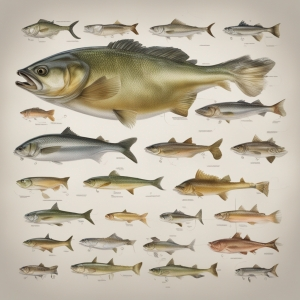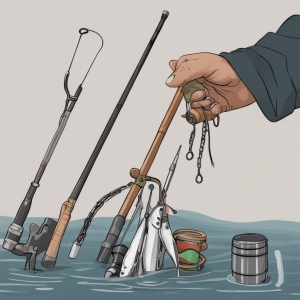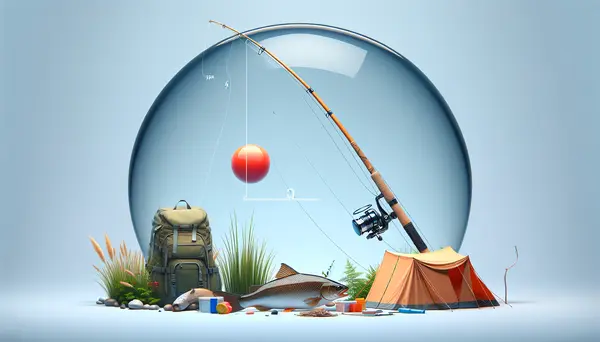Table of Contents:
Introduction to Fishing Terminology for Beginners
Welcome to Buzzerfish, your expert guide to fishing and camping. Today, we will demystify popular fishing terms in a way that even first-timers will easily understand. The world of fishing can seem a bit daunting at first. With all its terminology, it feels like learning a different language. But worry not, we're here to help navigate those waters!
A deep understanding of fishing terminology not only enables you to engage in expert angler conversations but also allows you to comprehend fishing manuals, understand regulations, and get the best out of your fishing gear. This article will guide you through essential terms like hook, line, and sinker, aiming to give you confidence the next time you're at the bait shop or out on the water. So, let's dive into the fascinating language of fishing!
Understanding the Basics: Hook, Line, and Sinker
For all the beginners out there, let's decode the mysteries of hook, line, and sinker - three essential parts of a fishing setup.
The hook is the part of the gear that catches the fish. Simply put, this is a device that is attached to the end of a fishing line and baits the fish. It's available in various types and sizes, choosing the right one depends on the type of fish you are after.
The line connects you to the fish. It's a cord that links the fishing rod to the hook. The line is important as it determines how deep your hook and bait will sink and allows you to pull the fish in once hooked. The type and strength of the line can vary depending on the fishing environment and the size of the fish.
The sinker (also known as a weight) is attached to the fishing line and helps it sink in water. This is crucial when you want to fish at greater depths or when fishing in areas with a strong current. Sinkers are available in different shapes and weights, again choosing the right one depends on your fishing conditions.
By understanding these basic components, you're already well on your way to increasing your fishing knowledge and boosting your angling abilities.
Advantages and Disadvantages of Learning Fishing Terminology
| Reasons | Pro | Contra |
|---|---|---|
| Understanding Instructions | Easier to follow guides and tutorials | Can be confusing to memorize all terms |
| Interacting with Other Fishermen | Promotes better communication | May feel overwhelmed or intimidated |
| Enhancing Fishing Skills | Knowing terms can lead to better techniques | Limited use if not interested in professional fishing |
Decoding Common Fishing Terms

Now that we’ve clarified the basic fishing elements of hook, line, and sinker, let's demystify some more terms often used in the angling world.
Bait: This is a substance used to attract and catch fish. Baits can be live, like worms or minnows, or artificial such as plastic worms or spinners.
Cast: To cast is to throw out your fishing line into the water using a fishing rod. The distance and location of your cast can greatly influence your success.
Chumming: This is the practice of luring fish by throwing baited substances into the water. It's a strategic method to attract the fish to your fishing area.
Drag: The drag is a part of your fishing reel that lets the line be pulled out under pressure. Knowing how to properly adjust the drag is key for fighting and landing a fish.
Tackle: Tackle is a general term used for all fishing equipment, including rods, reels, lines, hooks, baits, etc.
Understanding these terms is like having your own fishing dictionary, making your next fishing trip not only more fun but also effective!
Your Guide to Fishing Gear: Exploring Hook, Line, and Sinker
Whether you're preparing for a weekend by the water, or gearing up for a fishing competition, getting familiar with your fishing gear is the first step. In this section, we'll explore the uses, types, and selection tips for the fundamental fishing gear: hook, line, and sinker.
The hook with its specific shape and sharp end is designed to snag the fish's mouth. It's important to select your hook size and type based on the fish species you aim for. Bigger fish usually require larger hooks, while smaller hooks are suitable for small to mid-sized fish. The hook types range from J-hooks to circle hooks, each with its specific purpose and method of catching fish.
The line is your connection line between you and the fish. While they may seem similar, lines can vary in material, weight, color, and visibility underwater. Monofilament lines are popular for their versatility and forgiveness, while fluorocarbon lines offer a near-invisible look underwater, perfect for clear-water fishing. Braid lines are well-known for their incredible strength and are excellent for deep-water fishing.
The sinker on your fishing line ensures your baited hook reaches the desired depth in the water. There are several types of sinkers. Split shot sinkers are great for small baits and shallow water. Pyramid sinkers work wonders in fast currents and deeper water due to their shape. Choosing the right sinker will depend on your fishing style, the depth, and the underwater current.
By knowing your gear, you are one step closer to a successful fishing adventure. The secret to being a great angler isn't just knowing how to use your gear, but understanding why and when to use it.
Hands on the Rod: Using Fishing Equipment Right

Now, let's move from understanding fishing gear to actually using it. Implementing your knowledge about the hook, line, and sinker in real fishing scenarios is the next big step in becoming a promising angler.
Starting with the hook, make sure it's sharp before you cast your line. A sharp hook is often overlooked but can significantly improve your chances of successfully catching fish. Push the point of your hook into your thumbnail, if it slides off, it's time to sharpen!
Remember, the line strength should match the weight of the fish you're targeting. For instance, if you're aiming for heavy-weight fish, you'll need a stronger, more durable line. Also, have an idea of the water depth and current when deciding on the weight of your line.
The role of the sinker is to ensure your baited hook descends the desired depth. Be aware of the conditions you're fishing under. In a slow-moving or calm water body, a lightweight sinker will suffice. However, in faster currents or deeper waters, heavier sinkers are needed.
Last but not least, keep in mind the environment you are fishing in. Do your part in keeping our water bodies clean by making sure not to leave any hooks, lines, or sinkers behind.
Conclusion
Understanding the meaning and purpose of fishing terms and gear like hook, line, and sinker is the foundation of successful fishing. As with any skill, practice is crucial, so don't worry if you don't get it right the first time. With consistent effort and time spent on the water, you'll be able to master these terms and gear like a pro. This knowledge will enable you to make better equipment choices, enhance your fishing skills, and most importantly, enjoy the wonderful world of fishing.
Fishing Made Easy: A Step-by-Step Guide

Now that you're familiar with the vital terms and gear, let's take you through a simple, step-by-step guide to get you started on your fishing journey.
Step 1: Gathering Your Gear: Every fishing trip starts with gathering the essential gear - hook, line, sinker, and rod. Remember to select the appropriate gear based on the type of fishing you plan to do, and the fish you aim to catch.
Step 2: Bait Your Hook: Once your rod is set up, you will need to bait your hook. This can be done using different types of bait, depending on what fish you want to lure. Always handle the hook carefully to avoid any injury.
Step 3: Cast Your Line: With your hook baited, it's time to cast your line. The art of casting takes practice. The idea is to get your bait as near as possible to where the fish might be. Some anglers prefer to cast and wait, while others like to continuously cast and reel in their line.
Step 4: Be Patient: Fishing requires patience. Once the line is in the water, it's a waiting game. Keep a keen eye on your rod tip for any signs of a bite.
Step 5: Reel in Your Catch: Once you feel a tug on your line, it's time to reel in your catch. Remember to keep your rod's tip high and reel in slowly to avoid breaking the line.
Each fishing trip is an experience, whether you make a considerable catch or not. With time, you'll master the art of fishing, and remember, the most crucial part of fishing is enjoying the serenity and beauty of nature.
Conclusion: Ready to Cast Your Line
With the essential fishing terms demystified, you're now better equipped to hit the water. A solid grasp on fishing language can significantly enhance your angling experience and help you communicate more effectively with fellow anglers. It's not just about hook, line, and sinker, understanding terms such as bait, cast, chumming, drag, and tackle elevate your proficiency and paves the way for other advanced fishing concepts.
Remember that fishing is a learning journey. As you cast your line and gain experience, you'll master even more terminology and techniques. Feel free to revisit this guide anytime and keep educating yourself about the ever-fascinating world of fishing!
So, get your gear ready, head to the water, and enjoy reeling in your catch while conversing confidently with your fishing lingo!
Understanding Fishing Basics: A Beginner's Guide
What is meant by the term "hook" in fishing?
In fishing terminology, a "hook" refers to the sharp instrument that catches the fish by piercing its mouth once it goes for the bait.
What is a "line" in fishing?
A "line" refers to the cord that connects the fishing hook to the fishing rod. It is what you reel in or release when trying to catch a fish.
Can you explain what "sinker" is in fishing?
A "sinker" considers the weight used in fishing to force the bait or lure to sink faster or to reach the bottom of the water body.
What does "bait" mean in fishing?
"Bait" is any substance used to attract and catch fish, e.g., on the end of a fishing hook, or inside a fish trap.
What is "casting" in fishing?
"Casting" is a term used to describe the act of throwing bait or a lure using a fishing line out over the water by means of a fishing rod.







